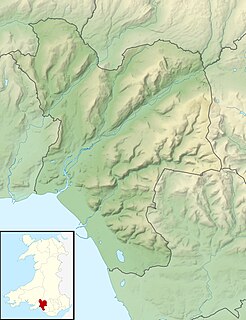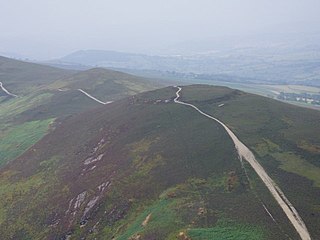 Ramparts of Buarth-y-Gaer, along southeast side. | |
| Location | summit of Mynydd-y-Gaer, Neath Port Talbot, Wales (OS Grid ref SS765939) |
|---|---|
| Region | South Wales |
| Coordinates | 51°37′39″N3°47′06″W / 51.6276°N 3.7849°W Coordinates: 51°37′39″N3°47′06″W / 51.6276°N 3.7849°W |
| Type | Hillfort |
| Area | 1.1 ha (2.7 acres) |
| History | |
| Periods | Iron Age |
| Cultures | Celtic Brittonic |
| Site notes | |
| Condition | A single bank and ditch, damaged by quarrying on south side. |
| Public access | No |
| Reference no. | GM054 |
Buarth-y-Gaer (pronounced [ˈbɪ.arθ ə ɡɑːɨr] ) is an Iron Age hillfort or enclosure on the summit of Mynydd-y-Gaer, 300 m (980 ft) above sea level. It is in Briton Ferry community, near Neath, in Neath Port Talbot, South Wales. A large hilltop enclosure is bounded by a single bank and ditch. Within the enclosed area is a Bronze Age burial mound.
The Iron Age is the final epoch of the three-age system, preceded by the Stone Age (Neolithic) and the Bronze Age. It is an archaeological era in the prehistory and protohistory of Europe and the Ancient Near East, and by analogy also used of other parts of the Old World. The three-age system was introduced in the first half of the 19th century for the archaeology of Europe in particular, and by the later 19th century expanded to the archaeology of the Ancient Near East. Its name harks back to the mythological "Ages of Man" of Hesiod. As an archaeological era it was first introduced for Scandinavia by Christian Jürgensen Thomsen in the 1830s. By the 1860s, it was embraced as a useful division of the "earliest history of mankind" in general and began to be applied in Assyriology. The development of the now-conventional periodization in the archaeology of the Ancient Near East was developed in the 1920s to 1930s. As its name suggests, Iron Age technology is characterized by the production of tools and weaponry by ferrous metallurgy (ironworking), more specifically from carbon steel.

A hillfort is a type of earthworks used as a fortified refuge or defended settlement, located to exploit a rise in elevation for defensive advantage. They are typically European and of the Bronze and Iron Ages. Some were used in the post-Roman period. The fortification usually follows the contours of a hill, consisting of one or more lines of earthworks, with stockades or defensive walls, and external ditches. Hillforts developed in the Late Bronze and Early Iron Age, roughly the start of the first millennium BC, and were used in many Celtic areas of central and western Europe until the Roman conquest.

Mynydd-y-Gaer is a hill that sits on the boundaries between the South Wales communities of Baglan, Cwmavon and Briton Ferry,, all within Neath Port Talbot county borough. The summit, at 314 m (1,030 ft), has grassland fields subdivided by dry stone walls. Foel Fynyddau lies 2 km to east. To the south is the coastal plain of the Severn Estuary. To the West is the Vale of Neath. To the north is the Crythan Brook and the town of Neath. It has numerous prehistoric monuments, and evidence of occupation in medieval times, as well as 19th and 20th century coalmining.











